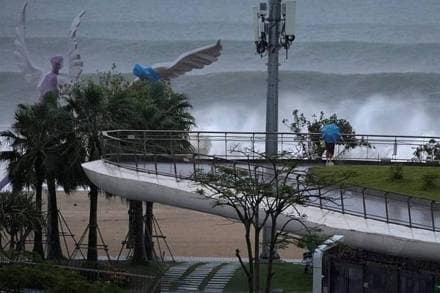Typhoon Ragasa, the world’s most powerful tropical cyclone this year, approached Hong Kong as it made a landfall in adjoining Taiwan. The storm brought the city’s aviation hub to a standstill, Reuters reported.
Typhoon Ragasa forces Hong Kong airport shutdown
Hong Kong International Airport has imposed a 36-hour shutdown, the first time passenger flights have been halted for such a long stretch. All departures and landings have been cancelled starting Tuesday evening. Live tracker data shows the typhoon is currently about 156 km south of Shenzhen and is expected to keep moving west at a pace of 20–25 km per hour over the next few hours (last updated 5hrs ago). The closure is set to impact thousands of tourists and international flyers, with many flights facing delays, reschedules, or cancellations. Normal operations are expected to resume by 6 am on Thursday.
Beyond flight cancellations and revenue losses, airlines are also tasked with protecting their fleets from hurricane-force winds and torrential rains.
Taiwan struggles with deadly flooding
Taiwan has been battered since Monday by the outer rim of Typhoon Ragasa. Once a super typhoon, Ragasa has now weakened but is still wreaking havoc in southern China and Hong Kong. In Guangfu, a small town in eastern Hualien County, torrential rain triggered by Ragasa caused a barrier lake, formed after recent landslides, to burst.
Casualties
At least 15 people were confirmed dead, all in Guangfu, after floodwaters destroyed homes and a key road bridge, according to Reuters. The number of people initially reported missing stood at 152 but was later revised to 17 after many were found alive, officials said.
Taiwan Premier Cho Jung Tai, who visited the disaster zone on Wednesday, asked for the need for accountability. “For the 14 who have tragically passed away, we must investigate why evacuation orders were not carried out in the designated areas,” Cho said before the death toll rose to 15 in the afternoon. “This is not about assigning blame, but about uncovering the truth.”
Survivors recalled the wreckage as waters flooded in. “We will not return until the overflow is finished or the risk of it bursting is reduced. It’s too dangerous,” said a woman named Tsai, sheltering with her family at a local elementary school. “We live on an upper floor and saw there wasn’t too much danger, so I brought the kids out to experience this heavy rain and wind,” a 40-year-old Shenzhen resident surnamed Liang said. “We walked along the open road to make sure to stay safe.”
Rescue efforts in Hualien
Rescue teams from across Taiwan have rushed to Hualien, one of the worst-hit areas. The military has sent 340 troops to help. In Guangfu, soldiers used an armoured personnel carrier to move through thick mud and went door-to-door delivering bottled water and instant noodles. Damaged cars, fallen trees and scooters were left scattered around the streets.
The current devastation has revived memories of Typhoon Morakot in 2009, which devastated southern Taiwan. That disaster killed about 700 people and caused an estimated $3 billion in damage.
Mass relocation of aircraft
Ahead of the typhoon’s landfall on Wednesday, nearly 80% of aircraft belonging to Hong Kong’s four main airlines were relocated or grounded at airports across Japan, China, Cambodia, Europe, Australia, and beyond, according to Flightradar24 tracking data, Reuters reported. Business jets also made their way out of the city, the Hong Kong Business Aviation Centre confirmed. The Hong Kong International Airport is ranked the world’s busiest for cargo and ninth for international passenger traffic.
Cathay Pacific Airways, Hong Kong’s largest carrier, admitted the typhoon would have “a significant impact” on operations. More than 500 long and regional flights were cancelled, the airline said. “We are positioning some of our aircraft away from Hong Kong and expect a staggered and gradual resumption to our schedule throughout Thursday into Friday,” he said the airline in a statement to Reuters.
Smaller Hong Kong-based Greater Bay Airlines, which operates seven planes, said it had parked all its aircraft at airports in Japan and China as a precaution. Its fleet of Boeing 737s was moved out of Hong Kong before the storm’s arrival.
Hong Kong Airlines also shifted almost its entire fleet of 28 aircraft, keeping only one plane in the city, according to tracking data. Airlines often move aircraft to safer airports during storms to ensure they can immediately resume services once weather conditions improve.
